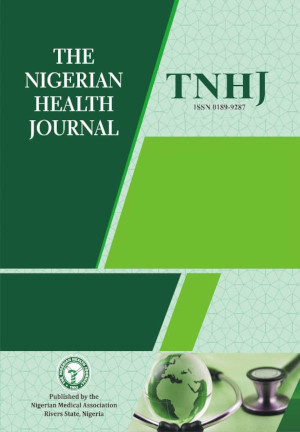Pregnancy Outcome of HIV-Infected Women on Anti-Retroviral Therapy in a Treatment Centre in Port Harcourt, Nigeria: a retrospective analysis
Keywords:
HAART, HIV, PMTCT, pregnancy, Rivers State, NigeriaAbstract
Introduction: There are conflicting reports of adverse pregnancy outcomes following the administration of antiretroviral treatment (ARVs) to HIV-positive pregnant women. The aim of this study was to assess the magnitude of adverse effects of antiretroviral drugs and to underscore their public health importance in limiting adverse pregnancy outcomes in newborns.
Methods: The study was a retrospective analysis of medical records of HIV-infected pregnant women who received anti-retroviral treatment (PMTCT) at the University of Port Harcourt Teaching Hospital between January 2010 and December 2013. Data was analyzed using Epi Info Version 7 Statistical Package. The level of significance was set at p≤ 0.05.
Results: A total of 290 medical records were examined: 198 (68.28%) women commenced antiretroviral treatment before pregnancy, while 11 (3.79%) started in 2nd trimester of pregnancy. On deliveries: 263 (90.69%) were live births, while 27 (9.31%) were stillbirths. Apgar scores: 268 (92.41%) of the newborns had scores ≥7, while only 22 (7.59%) had Apgar scores less than 7. On birth weights: 263 (90.69%) had birth weights of ≥ 2,500 grams, while only 27 (9.31%) had low birth weights. Concerning haemoglobin levels: 162 (55.86%) of neonates had levels above 10g/dl, while 128 (44.14%) had below 10g/dl. On timing of delivery: only 44 (15.17%) were preterm, while the rest 246 (84.83%) were born full term.
Conclusion: The study underscores the public health significance of antiretroviral treatment in the prevention of adverse pregnancy outcomes in newborns and recommends its early initiation for maximum impact in the reduction of adverse pregnancy outcomes.
References
UNAIDS/WHO. Global AIDS Response: Progress Reporting. Geneva: UNAIDS/WHO; 2015.
WHO/UNAIDS/UNICEF. Global HIV/AIDS Response: Epidemic update and health sector progress towards Universal Access. Geneva: WHO/UNAIDS/UNICEF; 2011.
Naniche D, Bardají A, Lahuerta M, Berenguera A, Mandomando I, Sanz S, Aponte JJ, Sigauque B, Alonso PL, Menéndez C. Impact of maternal human immunodeficiency virus infection on birth outcomes and infant survival in rural Mozambique. Am J Trop Med Hyg. 2009;80(5):870-6.
Onakewhor J, Olagbuji B, Ezeanochie M. Pregnancy Outcome among HIV Positive Women Receiving Antenatal HAART versus Untreated Maternal HIV Infection. J Coll Physicians Surg Pak. 2011; 21 (6): 356-9.
National Agency for the Control of HIV/AIDS (NACA). Global AIDS Response: Country Progress Report. Abuja, Nigeria: NACA; 2014. p. 17-22.
Ibeziako NS, Agozie CU, Emodi IJ, Ayuk AC, Iloh KK, Ikefuna AN.Mother-to-child transmission of HIV: the pre-rapid advice experience of the university of Nigeria teaching hospital Ituku/Ozalla, Enugu, South-east Nigeria, BMC Research Notes 2012; 5:305 doi:10.1186/1756-0500-5-305. [Cited 2014 Jun 8]. Available from: http://www.biomedcentral.com/1756-0500/5/305
World Health Organization (WHO). Antiretroviral Drugs for Treating Pregnant Women and Preventing HIV Infection in Infants: Recommendations for a Public Health Approach. Geneva: WHO; 2010.
Kuhn L, Aldrovandi GM, Sinkala M, Kankasa C,Mwiya M, Thea DM. Potential Impact of New WHO Criteria for ART treatment for prevention of mother-to-child HIV transmission. AIDS 2010; 24 (9):1374-7.
United Nations Programme on HIV/AIDS (UNAIDS). Global AIDS Epidemics Report. Geneva: UNAIDS; 2012.
Gourlay A, Birdthistle I, Mburu G, Iorpenda K, Wringe A. Barriers and facilitating factors to the uptake of antiretroviral drugs for prevention of mother-to-child transmission of HIV in sub-Saharan Africa: a systematic review. J Int AIDS Soc 2013; 16:18588. doi: 10.7448/IAS.16.1.18588. [Cited 2014 Jun 8]. Available from: https://www.ncbi.nlm.nih.gov/pmc/articles/PMC3434106/
Ciaranello AL, Perez F, Keatinge J, Park JE, Engelsmann B, Maruva M, Freedberg K A. What will it take to eliminate pediatric HIV? Reaching WHO target rates of mother-to-child HIV transmission in Zimbabwe: a model-based analysis. PLoS Medicine 2012; 9(1): e1001156. doi:10.1371/journal.pmed.1001156. [Cited 2014 Jun 8]. Available from: http://www.ncbi.nlm.nih.gov/pubmed/22253579
UNAIDS/WHO. HIV/AIDS epidemic Update. Geneva: UNAIDS/WHO; 1998.
De Santis M, Carducci B, De Santis L, Cavaliere AF, Straface G. Periconceptional exposure to efavirenz and neural tube defects.Arch Intern Med. 2002; 162(3):355. [Cited 2014 Jun 8]. Available from: http://www.ncbi.nlm.nih.gov/pubmed/11822930
Ford N, Mofenson L, Shubber Z, Calmy A, Andrieux-Meyer I, Vitoria M, Shaffer N, Renaud F. Safety of efavirenz in the first trimester of pregnancy: an updated systematic review and meta-analysis. AIDS. 2014 Mar;28 Suppl 2:S123-31. doi: 10.1097/QAD.0000000000000231. [Cited 2014 Jun 5]. Available from: http://www.ncbi.nlm.nih.gov/pubmed/?term=AIDS.+2014+Mar%3B28+Suppl+2%3AS123-31.
Watts DH, Mofenson LM. Antiretrovirals in pregnancy: a note of caution. J Infect Dis. 2012; 206(11): 1639–41.
Chen JY, Ribaudo HJ, Souda S, Parekh N, Ogwu A, Lockman S, Shapiro RL. Highly active antiretroviral therapy and adverse birth outcomes among HIV-infected women in Botswana. J Infect Dis. 2012; 206(11): 1695–705.
Young S, Murray K, Mwesigwa J, Natureeba P, Osterbauer B, Achan J, Cohan D. Maternal nutritional status predicts adverse birth outcomes among HIV-infected rural Ugandan women receiving combination antiretroviral therapy. PloS One 2012; 7(8), e41934. doi:10.1371/journal.pone.0041934. [Cited 2014 Jun 5]. Available from: http://www.ncbi.nlm.nih.gov/pmc/articles/PMC3413694/
Olagbuji BN, Ezeanochie MC, Ande AB, Oboro VO. Obstetric and perinatal outcome in HIV positive women receiving HAART in urban Nigeria. Arch Gynecol Obstet. 2010; 281(6): 991–4.
Li N, Matchi E, Spiegelman D, Chalamilla G, Hertzmank E, Sando D, Fawzi W. Maternal mortality among HIV-infected pregnant women in Tanzania. Acta Obstet Gynecol Scand. 2014; 93(5): 463–8.
Baroncelli S, Tamburrini E, Ravizza M, Dalzero S, Tibaldi C, Ferrazzi E, Floridia M. Antiretroviral treatment in pregnancy: a six-year perspective on recent trends in prescription patterns, viral load suppression, and pregnancy outcomes. AIDS Patient Care and STDS. 2009; 23(7): 513–20.
von Linstow ML, Rosenfeldt V, Lebech AM, Storgaard M, Hornstrup T, Katzenstein TL, Pedersen G, Herlin T, Valerius NH, Weis N. Prevention of mother-to-child transmission of HIV in Denmark, 1994-2008. HIV Med. 2010; 11(7): 448–56.
Downloads
Published
How to Cite
Issue
Section
License
Copyright (c) 2017 The Nigerian Health Journal

This work is licensed under a Creative Commons Attribution-NonCommercial-NoDerivatives 4.0 International License.
The Journal is owned, published and copyrighted by the Nigerian Medical Association, River state Branch. The copyright of papers published are vested in the journal and the publisher. In line with our open access policy and the Creative Commons Attribution License policy authors are allowed to share their work with an acknowledgement of the work's authorship and initial publication in this journal.
This is an open access journal which means that all content is freely available without charge to the user or his/her institution. Users are allowed to read, download, copy, distribute, print, search, or link to the full texts of the articles in this journal without asking prior permission from the publisher or the author.
The use of general descriptive names, trade names, trademarks, and so forth in this publication, even if not specifically identified, does not imply that these names are not protected by the relevant laws and regulations. While the advice and information in this journal are believed to be true and accurate on the date of its going to press, neither the authors, the editors, nor the publisher can accept any legal responsibility for any errors or omissions that may be made. The publisher makes no warranty, express or implied, with respect to the material contained herein.
TNHJ also supports open access archiving of articles published in the journal after three months of publication. Authors are permitted and encouraged to post their work online (e.g, in institutional repositories or on their website) within the stated period, as it can lead to productive exchanges, as well as earlier and greater citation of published work (See The Effect of Open Access). All requests for permission for open access archiving outside this period should be sent to the editor via email to editor@tnhjph.com.




